 |
 |
 |
 |
Harmonising the Nuclear Licensing Process for Emerging Technologies: A Global Path Forward
Nuclear Energy Agency NEA No. 7616, OECD, Nuclear Safety Technology and Regulation 2022
Independent safety regulation has been a hallmark of the global nuclear power sector from its beginnings. Industry and government have long understood the importance of a predictable and adaptable regulatory structure and have worked co-operatively to ensure the safety of civilian nuclear energy throughout the lifetime of nuclear power projects – design, construction, operations and decommissioning.
|
Innovation brings new and sometimes unknown risks, for example in the areas of digital instrumentation, data security and privacy. The adoption of new technologies in nuclear energy is also changing the business models that have historically governed the sector. The lessons learnt from other sectors, which have managed both the regulation of innovative technologies and global harmonisation, are valuable for the nuclear sector as it is implementing advanced, disruptive technologies.
|
 |
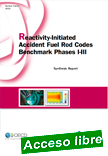 |
Reactivity-Initiated Accident Fuel Rod Codes Benchmark Phases I-III: Synthesis Report
Nuclear Energy Agency NEA No. 7577, OECD, Nuclear Safety 2022
One of the key areas in fuel safety is the analysis of fuel behaviour under reactivity-initiated accident conditions. Reactivity-initiated accident fuel rod codes have been developed for a significant period of time and they all have shown their ability to reproduce some experimental results with a certain degree of adequacy. However, they sometimes rely on different specific modelling assumptions whose influence on the final results of the calculations is difficult to evaluate.
|
This report summarises three phases of benchmark conducted by the NEA between 2010 and 2019 with codes for calculating fuel behaviour in reactivity initiated accidents. Building on previous NEA reports, it provides recommendations for future research and code enhancements for safety analysis regarding reactivity accidents.
|
 |
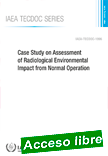 |
Case Study on Assessment of Radiological Environmental Impact from Normal Operation
IAEA-TECDOC-1996 ¦ 244 pages ¦ 213 figures ¦ Date published: 2022
As an integral part of the International Project on Innovative Nuclear Reactors and Fuel Cycles (INPRO), several collaborative projects were established by its members. The IAEA/INPRO Collaborative Project on Environmental Impact Benchmarking Applicable for Nuclear Energy Systems under Normal Operation (ENV) was one of them. This publication is the outcome of the ENV summarising results developed under this project by the groups of national experts.
|
. It presents a set of examples of different approaches for estimating environmental impact from nuclear power plants (NPPs) under normal operation conditions in different countries based on participants’ experience and considering the IAEA Safety Standard on a generic framework for consideration of radiological environmental impact. It also contributes to the development of a common understanding in assessing releases from new NPPs and associated activities in terms of the radiation dose to members of the public. This publication will contribute to further improvement of the INPRO methodology and can help Member States applying it to perform a nuclear energy system assessment in the area of environmental impact of stressors.
|
 |
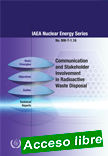 |
Communication and Stakeholder Involvement in Radioactive Waste Disposal
IAEA Nuclear Energy Series No. NW-T-1.16 ¦ STI/PUB/1920 ¦ 92 pages ¦ Date published: 2022
Communication and stakeholder involvement are essential components for a successful disposal programme. Experience around the world suggests that the scientific and technological bases for the safe disposal of radioactive waste are available — disposal solutions exist or can be developed based on established knowledge.
|
However, concerns and opposition among the public and other stakeholders could slow or even prevent the implementation of needed disposal solutions. This publication provides practical guidance on communication and stakeholder involvement for countries embarking on, relaunching or revising a disposal programme. It draws upon past experiences and emphasizes that practical implementation requires adjusting to the evolving context as given by the national, social and political circumstances. The primary intended users of this publication include those working in the field of radioactive waste management in government, regulatory bodies and industry, an especially in organizations responsible to implement solutions for radioactive waste disposal.
|
 |
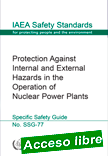 |
Protection Against Internal and External Hazards in the Operation of Nuclear Power Plants
IAEA Safety Standards Series No. SSG-77 ¦ English ¦ STI/PUB/1991 ¦ 83 pages ¦ Date published: 2022
This Safety Guide provides specific recommendations on protection against internal and external hazards in the operation of nuclear power plants. It provides new or updated recommendations derived from enhanced understanding of operational aspects of hazards and combinations of hazards. Operating experience gained from incidents and accidents in nuclear power plants around the world has demonstrated that fire can be an important risk contributor in many Member States.
|
However, there are other internal and external hazards that have also to be considered in the design and operation of nuclear power plants. This Safety Guide supersedes and expands the scope of lAEA Safety Standards Series No. NS- G-2. 1, Fire Safety in the Operation of Nuclear Power Plants, to include recommendations on these other hazards.
|
 |
 |
Emergency Preparedness and Response Information Management System (EPRIMS) Guide for Authorized EPRIMS Users. EPRIMS 3.0
English EPR-EPRIMS (2021) ¦ English ¦ 129 pages ¦ Date published: 2022
The purpose of this publication is to serve as another step in making EPRIMS more accessible both to users who may already be familiar with the system and to users who are completely new to the system. In doing so, it is intended to further promote the broad use of EPRIMS as a platform for collecting and sharing the
|
results of self-assessment and to contribute to the global enhancement and harmonization of emergency preparedness and response arrangements.
|
 |
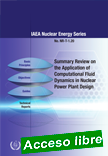 |
Summary Review on the Application of Computational Fluid Dynamics in Nuclear Power Plant Design
IAEA Nuclear Energy Series NR-T-1.20 ¦ English ¦ STI/PUB/1932 ¦ 80 pages ¦ Date published: 2022
This publication documents the results of an IAEA coordinated research project (CRP)on the application of computational fluid dynamics (CFD) codes for nuclear power plant design. The main objective was to benchmark CFD codes, model options and methods against CFD experimental data under single phase flow conditions.
|
This publication summarizes the current capabilities and applications of CFD codes, and their present qualification level, with respect to nuclear power plant design requirements. It is not intended to be comprehensive, focusing instead on international experience in the practical application of these tools in designing nuclear power plant components and systems. The guidance in this publication is based on inputs provided by international nuclear industry experts directly involved in nuclear power plant design issues, CFD applications, and in related experimentation and validation highlighted during the CRP.
|
 |
 |
Benchmarks of Fuel Burnup and Material Activation Computational Tools Against Experimental Data for Research Reactors
IAEA TECDOC No. 1992 ¦ English 276 pages ¦ Date published: 2022
The design, operation, safety and decommissioning of research reactors involves complex processes that can be understood and improved through numerical analysis and benchmarking. This publication provides the final consolidated results of an IAEA coordinated research project (CRP).
|
It comprises the benchmark studies, details of the calculations in the annexes and individual reports of the CRP participants in the on-line supplementary files. This publication is intended for operating organizations, researchers, regulatory bodies, reactor designers, technical support organizations and other parties interested in benchmarking the computer codes and models they use for research reactor operation and safety analysis.
|
 |
| |
|
|
 |
| |
|
|
 |
| |
|
|

|
|
|
| |
|
|
| |
| |
|
|
| |
| |
|
|
| |
| |
|
|
|
| |
| |
